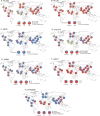Joint ancestry and association test indicate two distinct pathogenic pathways involved in classical dengue fever and dengue shock syndrome
- PMID: 29447178
- PMCID: PMC5813895
- DOI: 10.1371/journal.pntd.0006202
Joint ancestry and association test indicate two distinct pathogenic pathways involved in classical dengue fever and dengue shock syndrome
Abstract
Ethnic diversity has been long considered as one of the factors explaining why the severe forms of dengue are more prevalent in Southeast Asia than anywhere else. Here we take advantage of the admixed profile of Southeast Asians to perform coupled association-admixture analyses in Thai cohorts. For dengue shock syndrome (DSS), the significant haplotypes are located in genes coding for phospholipase C members (PLCB4 added to previously reported PLCE1), related to inflammation of blood vessels. For dengue fever (DF), we found evidence of significant association with CHST10, AHRR, PPP2R5E and GRIP1 genes, which participate in the xenobiotic metabolism signaling pathway. We conducted functional analyses for PPP2R5E, revealing by immunofluorescence imaging that the coded protein co-localizes with both DENV1 and DENV2 NS5 proteins. Interestingly, only DENV2-NS5 migrated to the nucleus, and a deletion of the predicted top-linking motif in NS5 abolished the nuclear transfer. These observations support the existence of differences between serotypes in their cellular dynamics, which may contribute to differential infection outcome risk. The contribution of the identified genes to the genetic risk render Southeast and Northeast Asian populations more susceptible to both phenotypes, while African populations are best protected against DSS and intermediately protected against DF, and Europeans the best protected against DF but the most susceptible against DSS.
Conflict of interest statement
The authors have declared that no competing interests exist.
Figures






Similar articles
-
A replication study confirms the association of GWAS-identified SNPs at MICB and PLCE1 in Thai patients with dengue shock syndrome.BMC Med Genet. 2014 May 17;15:58. doi: 10.1186/1471-2350-15-58. BMC Med Genet. 2014. PMID: 24884822 Free PMC article.
-
OSBPL10, RXRA and lipid metabolism confer African-ancestry protection against dengue haemorrhagic fever in admixed Cubans.PLoS Pathog. 2017 Feb 27;13(2):e1006220. doi: 10.1371/journal.ppat.1006220. eCollection 2017 Feb. PLoS Pathog. 2017. PMID: 28241052 Free PMC article.
-
Genetic risk for dengue hemorrhagic fever and dengue fever in multiple ancestries.EBioMedicine. 2020 Jan;51:102584. doi: 10.1016/j.ebiom.2019.11.045. Epub 2020 Jan 2. EBioMedicine. 2020. PMID: 31901861 Free PMC article.
-
Concordance of dengue viral load with disease severity and different clinical manifestations: A systematic review and meta-analysis.Indian J Med Microbiol. 2025 May-Jun;55:100852. doi: 10.1016/j.ijmmb.2025.100852. Epub 2025 Apr 15. Indian J Med Microbiol. 2025. PMID: 40239895
-
Functional RNA elements in the dengue virus genome.Viruses. 2011 Sep;3(9):1739-56. doi: 10.3390/v3091739. Epub 2011 Sep 15. Viruses. 2011. PMID: 21994804 Free PMC article. Review.
Cited by
-
Admixture Mapping of Sepsis in European Individuals With African Ancestries.Front Med (Lausanne). 2022 Mar 8;9:754440. doi: 10.3389/fmed.2022.754440. eCollection 2022. Front Med (Lausanne). 2022. PMID: 35345767 Free PMC article.
-
Discovery of Ganoderma lucidum triterpenoids as potential inhibitors against Dengue virus NS2B-NS3 protease.Sci Rep. 2019 Dec 13;9(1):19059. doi: 10.1038/s41598-019-55723-5. Sci Rep. 2019. PMID: 31836806 Free PMC article.
-
Ganoderma lucidum: Unutilized natural medicine and promising future solution to emerging diseases in Africa.Front Pharmacol. 2022 Aug 22;13:952027. doi: 10.3389/fphar.2022.952027. eCollection 2022. Front Pharmacol. 2022. PMID: 36071846 Free PMC article. Review.
-
SARS-CoV-2 infection in India bucks the trend: Trained innate immunity?Am J Hum Biol. 2021 Nov;33(6):e23504. doi: 10.1002/ajhb.23504. Epub 2020 Sep 23. Am J Hum Biol. 2021. PMID: 32965717 Free PMC article.
-
Health Challenges of the Pacific Region: Insights From History, Geography, Social Determinants, Genetics, and the Microbiome.Front Immunol. 2019 Sep 13;10:2184. doi: 10.3389/fimmu.2019.02184. eCollection 2019. Front Immunol. 2019. PMID: 31572391 Free PMC article. Review.
References
-
- Bhatt S, Gething PW, Brady OJ, Messina JP, Farlow AW, Moyes CL, et al. The global distribution and burden of dengue. Nature. 2013;496(7446):504–7. Epub 2013/04/09. doi: 10.1038/nature12060 ; PubMed Central PMCID: PMCPmc3651993. - DOI - PMC - PubMed
-
- WHO. Dengue haemorrhagic fever: diagnosis, treatment, prevention and control. 2nd ed. Geneva: World Health Organization; 1997. 84 p.
-
- Khor CC, Chau TN, Pang J, Davila S, Long HT, Ong RT, et al. Genome-wide association study identifies susceptibility loci for dengue shock syndrome at MICB and PLCE1. Nat Genet. 2011;43(11):1139–41. Epub 2011/10/18. doi: 10.1038/ng.960 ; PubMed Central PMCID: PMCPmc3223402. - DOI - PMC - PubMed
-
- Long HT, Hibberd ML, Hien TT, Dung NM, Van Ngoc T, Farrar J, et al. Patterns of gene transcript abundance in the blood of children with severe or uncomplicated dengue highlight differences in disease evolution and host response to dengue virus infection. J Infect Dis. 2009;199(4):537–46. Epub 2009/01/14. doi: 10.1086/596507 ; PubMed Central PMCID: PMCPmc4333209. - DOI - PMC - PubMed
-
- Hoang LT, Lynn DJ, Henn M, Birren BW, Lennon NJ, Le PT, et al. The early whole-blood transcriptional signature of dengue virus and features associated with progression to dengue shock syndrome in Vietnamese children and young adults. Journal of virology. 2010;84(24):12982–94. Epub 2010/10/15. doi: 10.1128/JVI.01224-10 ; PubMed Central PMCID: PMCPmc3004338. - DOI - PMC - PubMed
Publication types
MeSH terms
Substances
LinkOut - more resources
Full Text Sources
Other Literature Sources
Medical
Research Materials
Miscellaneous

